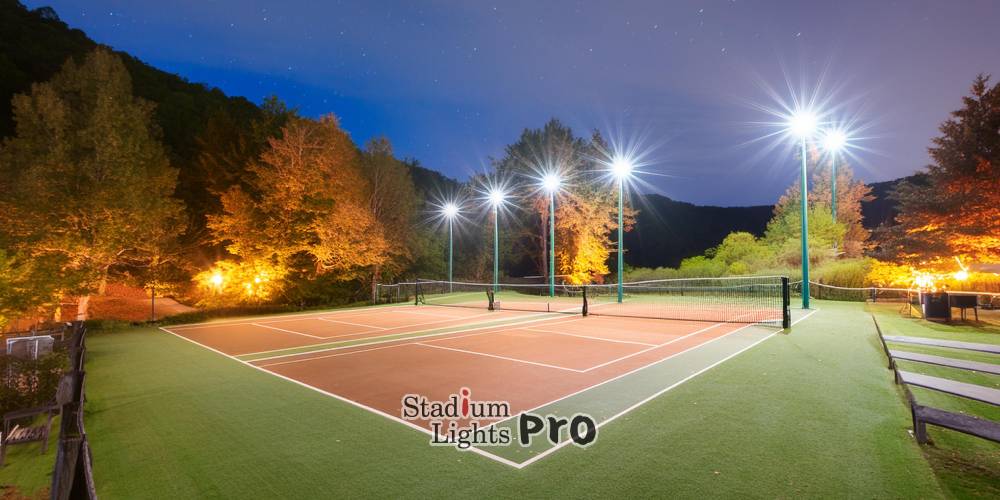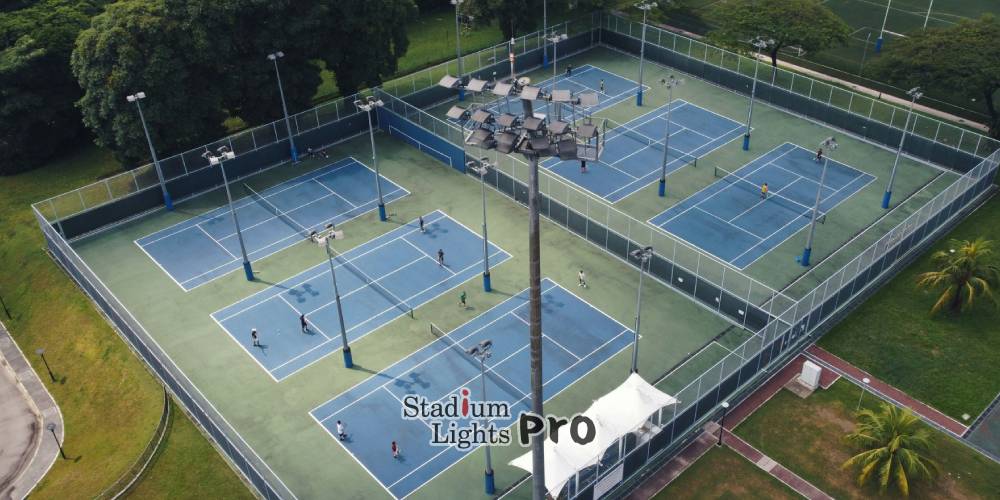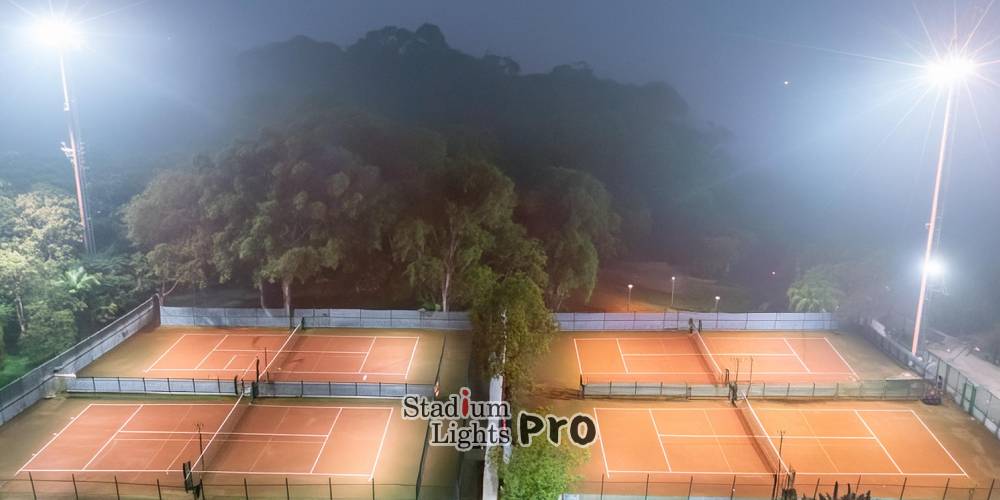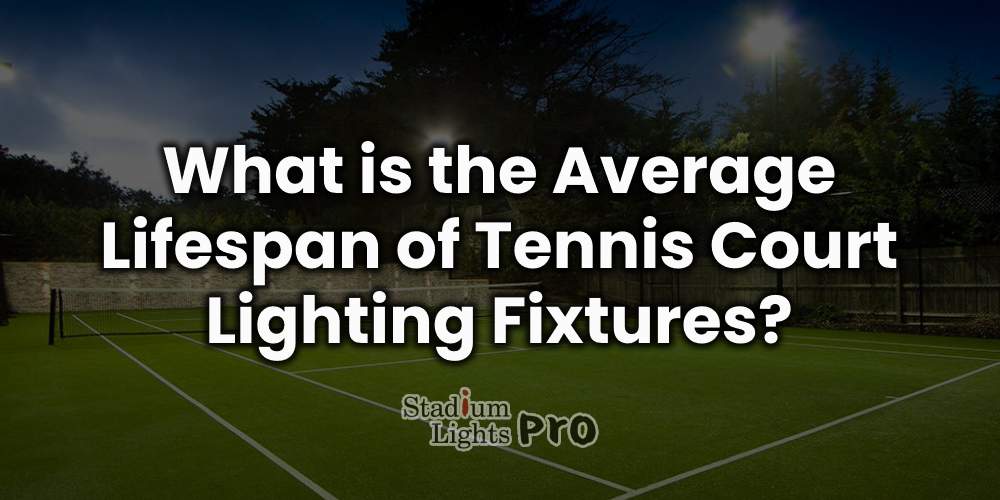Table of Contents
ToggleTypes of lighting fixtures
LED lighting has revolutionized tennis court illumination, offering several benefits tailored to the specific needs of these sporting venues. LED fixtures provide superior energy efficiency compared to traditional lighting options, resulting in cost savings for facility operators while reducing environmental impact. Additionally, LEDs offer precise control over light direction and intensity, allowing for customizable lighting designs that optimize visibility and minimize glare, thereby improving player performance and safety. LED fixtures also boast a longer lifespan, reducing maintenance requirements and ensuring uninterrupted play on the courts. Furthermore, LED technology enables dynamic lighting solutions that can adapt to different playing conditions and events, enhancing the overall experience for players and spectators alike. Overall, the adoption of LED lighting has transformed tennis court lighting, providing efficient, customizable, and reliable illumination for a better playing experience.

Floodlights
LED floodlights are among the most common fixtures used to illuminate tennis courts. These fixtures typically consist of multiple LED lamps arranged within a housing designed to distribute light evenly across the court surface. LED floodlights offer high efficiency and uniform illumination, ensuring optimal visibility for players and spectators alike. Their directional lighting capabilities allow for precise beam control, minimizing light spillage and glare while maximizing energy efficiency.
Pole-mounted fixtures
Pole-mounted LED fixtures are another popular option for lighting tennis courts. These fixtures are mounted on tall poles positioned around the perimeter of the court, providing overhead illumination that minimizes shadows and enhances visibility. Pole-mounted LED fixtures are often adjustable, allowing court managers to customize the angle and intensity of the light to suit different playing conditions. Besides, these fixtures are durable and weather-resistant, making them well-suited for outdoor tennis courts exposed to the elements.
Wall-mounted fixtures
In addition to overhead lighting, LED wall-mounted fixtures can be used to supplement illumination along the sidelines of tennis courts. These fixtures are typically installed on the walls of adjacent buildings or structures, providing additional light coverage where pole-mounted fixtures may not reach. LED wall-mounted fixtures offer versatility in terms of placement and directionality, allowing court managers to optimize light distribution and minimize dark spots along the court periphery.
Portable LED lighting systems
For temporary or mobile tennis court setups, portable LED lighting systems offer a convenient solution. These systems consist of freestanding LED fixtures mounted on portable poles or stands that can be easily moved and adjusted as needed. Portable LED lighting systems are ideal for events, tournaments, or temporary installations where permanent lighting infrastructure is not available or practical. Despite their portability, these fixtures deliver powerful illumination and can be quickly deployed to ensure optimal playing conditions.
Retrofit kits
For tennis courts with existing lighting infrastructure, LED retrofit kits provide a cost-effective way to upgrade to LED technology without the need for full fixture replacement. These kits consist of LED lamps or modules that can be installed into existing fixtures, converting them to energy-efficient LED lighting. LED retrofit kits offer the benefits of LED technology, including energy savings, long lifespan, and improved light quality, while minimizing installation time and costs associated with replacing entire fixtures.
Factors influencing the lifespan of lighting fixtures

The lifespan of lighting fixtures hinges on various factors, including the quality of materials, usage patterns, environmental conditions, and maintenance practices. High-quality materials, such as durable metals and impact-resistant plastics, contribute to longevity, while frequent usage or on-off cycles may accelerate wear and tear. Environmental factors like extreme temperatures or exposure to corrosive substances can hasten degradation, necessitating proper protection and maintenance. Regular inspections, cleaning, and servicing are essential for identifying and addressing potential issues before they escalate, ensuring optimal performance and preventing premature failure. Moreover, voltage stability is critical, as fluctuations can strain electrical components and lead to overheating or malfunction. By proactively managing these factors, it is possible to extend the lifespan of lighting fixtures and maintain their efficiency over time.
Quality of materials
The quality of materials used in the construction of lighting fixtures is a fundamental determinant of their performance and longevity. High-quality materials, such as robust metals, durable plastics, and reliable electronic components, contribute to the overall durability and resilience of the fixture. These materials are capable of withstanding environmental factors like temperature fluctuations, moisture, and physical impacts, thereby ensuring the fixture’s longevity. In contrast, fixtures constructed from lower-quality materials are more prone to premature degradation, leading to reduced lifespan and increased susceptibility to malfunctions or failures. high-quality materials contribute to the fixture’s ability to maintain consistent performance over time, delivering reliable illumination without significant deterioration in light output or quality. Consequently, investing in fixtures made from superior materials not only enhances durability but also minimizes maintenance requirements and operational disruptions, ultimately optimizing the overall value and effectiveness of the lighting system.
Usage frequency
The frequency of usage stands as a pivotal determinant impacting the lifespan of lighting fixtures on tennis courts. Fixtures that endure frequent use or extended operating hours are susceptible to accelerated wear and tear compared to those employed infrequently. The continuous operation or prolonged periods of illumination exert strain on the fixture’s components, encompassing LEDs, circuitry, and housing, hastening their degradation and potentially leading to failure. Likewise, fixtures subjected to frequent on-off cycles endure additional stress, particularly on sensitive electronic components, thereby shortening their lifespan. Managing and comprehending usage patterns emerge as imperative strategies for optimizing fixture longevity. Implementing measures to curtail unnecessary usage, such as turning off lights during downtime or utilizing timers to regulate operating hours, proves instrumental in mitigating wear and extending fixture lifespan.
Moreover, selecting fixtures specifically rated for the expected frequency of use and ensuring adequate ventilation and cooling mechanisms further bolster durability and reliability, ultimately maximizing the value and performance of the lighting system. This meticulous approach to usage management and fixture selection not only extends the lifespan of lighting fixtures but also enhances their overall efficiency and functionality, ensuring optimal illumination for tennis court users.
Environmental conditions
Environmental conditions play a crucial role in determining the lifespan of lighting fixtures. Factors such as temperature, humidity, exposure to moisture, and the presence of corrosive substances can significantly impact the durability and performance of fixtures. Extreme temperatures, whether hot or cold, can cause thermal expansion and contraction of materials, leading to stress and potential damage. High humidity levels can promote corrosion of metal components and degrade electrical connections, compromising the fixture’s integrity. Similarly, exposure to moisture, rain, or water ingress can cause short circuits, rust, and other forms of deterioration.
Harsh environmental elements such as saltwater, chemicals, or pollutants can accelerate corrosion and degrade materials, further reducing the lifespan of fixtures. Proper selection of fixtures designed to withstand specific environmental conditions, such as weatherproof or corrosion-resistant models, is essential for ensuring longevity. Additionally, regular maintenance, including cleaning, sealing, and protective coatings, can help mitigate the effects of environmental exposure and extend the lifespan of lighting fixtures in challenging outdoor or industrial environments.
Maintenance practices
Ensuring the longevity and optimal performance of LED lighting fixtures on tennis courts necessitates the implementation of effective maintenance practices. Regular inspections serve as the cornerstone of this endeavor, enabling the early detection of wear, damage, or malfunction. Coupled with routine cleaning procedures to eliminate accumulated dirt and debris, these inspections preserve the functionality of the fixtures, ensuring consistent and reliable illumination for players and spectators alike. Furthermore, periodic testing and calibration are indispensable in maintaining optimal performance levels, guaranteeing that the lighting system operates at peak efficiency. Timely replacement of components prevents degradation over time and contributes to enhanced energy efficiency, thus maximizing the lifespan of the fixtures.
In addition, prioritizing electrical safety checks is crucial for mitigating potential hazards and ensuring the well-being of players and personnel. By thoroughly documenting all maintenance activities, facility managers can engage in proactive planning and trend analysis, facilitating informed decision-making and ensuring the continued reliability and optimal illumination of tennis courts. This comprehensive approach to maintenance not only extends the lifespan of LED lighting fixtures but also enhances the overall playing experience, fostering a safe and enjoyable environment for all involved.
Maintenance

Maintaining LED lighting fixtures on tennis courts is paramount for ensuring their optimal performance, longevity, and the safety of all users. Regular inspections serve as a proactive measure to detect any signs of wear, damage, or malfunction before they escalate, thus minimizing the risk of unexpected failures during matches or practice sessions. Furthermore, routine cleaning is essential to remove accumulated dirt and debris, which can obstruct light output and compromise visibility on the court. Periodic testing and calibration of fixtures ensure that they continue to operate at peak efficiency levels, delivering consistent and uniform illumination across the playing surface.
Moreover, timely replacement of components such as bulbs or drivers prevents performance degradation over time and contributes to enhanced energy efficiency. Electrical safety checks are vital for identifying and mitigating potential hazards, safeguarding players, coaches, and maintenance personnel from any electrical risks. By maintaining comprehensive documentation of all maintenance activities, facility managers can track the performance and condition of lighting fixtures over time, enabling proactive planning and informed decision-making for future upgrades or replacements. This meticulous approach to maintenance not only ensures the reliability and safety of the lighting system but also enhances the overall playing experience for tennis court users.
Regular inspection of fixtures
Regular inspection of lighting fixtures is a critical aspect of maintenance, ensuring their continued functionality and performance. This involves systematically examining each fixture for any signs of wear, damage, or malfunction. Inspection procedures typically include checking for loose connections, damaged components, or signs of corrosion. By identifying potential issues early on, maintenance personnel can take timely corrective actions, preventing more significant problems and ensuring uninterrupted illumination on the tennis court. Additionally, regular inspections contribute to the overall safety of the facility by identifying and addressing any potential hazards posed by malfunctioning fixtures. Instituting a schedule for routine inspections helps to maintain consistency and ensures that fixtures remain in optimal condition for an extended lifespan.
Cleaning procedures
Cleaning procedures for LED lighting fixtures on tennis courts play a crucial role in preserving their performance and lifespan. Regular cleaning removes accumulated dirt, dust, and debris from the fixtures’ surfaces, ensuring optimal light output for players and spectators during matches and events. It’s essential to use gentle cleaning materials and mild detergent solutions to avoid damaging the fixtures’ delicate surfaces. Care should also be taken to prevent water or cleaning solutions from seeping into the electrical components, which could lead to malfunctions or hazards.
Moreover, clearing debris from around the fixtures prevents obstruction of light and airflow, further enhancing their efficiency. Establishing a routine cleaning schedule as part of ongoing maintenance efforts ensures that the fixtures remain in top condition, providing consistent and reliable illumination on the tennis court, contributing to a safe and enjoyable playing environment for all.
Lubrication of moving parts
Lubricating moving parts is a critical maintenance task necessary to ensure smooth operation and prevent premature wear and tear in equipment or machinery. By applying lubrication to moving components such as hinges, bearings, and gears, friction between surfaces is significantly reduced, which not only enhances performance but also extends the lifespan of the equipment. Regular lubrication creates a protective layer between moving parts, preventing direct metal-to-metal contact and minimizing the risk of corrosion or damage. It’s essential to use the appropriate type of lubricant for each specific part, considering factors such as temperature, load, and operating conditions.
Following the manufacturer’s recommendations for lubrication intervals and application techniques is crucial to ensure optimal effectiveness and prevent over-lubrication, which can attract dust and debris, leading to potential issues. Ultimately, proper lubrication of moving parts contributes to the overall efficiency, reliability, and longevity of equipment or machinery, reducing maintenance requirements and enhancing operational performance.
Testing of electrical components
Testing the electrical components of LED lighting fixtures on tennis courts is vital to ensure their safe and efficient operation. This process involves carefully inspecting wiring connections to confirm they’re securely fastened and undamaged. Moreover, maintenance personnel assess the functionality of electronic components like drivers and controllers, which regulate power distribution for optimal fixture performance. Voltage levels are also verified to prevent potential overloading or electrical failures. Regular electrical tests help identify any underlying issues before they escalate, minimizing the risk of hazards and maintaining system reliability. Adhering to industry standards and best practices ensures accuracy, and any abnormalities detected are promptly addressed to uphold safety standards, ensuring a safe environment for players and spectators.
Estimation of lifespan
Estimating the lifespan of lighting fixtures on tennis courts involves a holistic assessment of various factors, including the type and quality of fixtures, usage patterns, environmental conditions, maintenance practices, and manufacturer specifications. LED fixtures, renowned for their durability, typically outlast traditional options, while higher-quality materials contribute to prolonged lifespan. Understanding usage patterns aids in predicting wear and degradation rates, especially for fixtures subjected to frequent use or harsh environmental conditions. Maintenance practices such as regular inspections and cleaning play a pivotal role in preventing issues that could shorten the fixtures’ lifespan. Adherence to manufacturer specifications provides valuable insights, but real-world conditions may necessitate adjustments in estimations. By carefully considering these factors, facility managers can make informed decisions regarding fixture selection, maintenance schedules, and replacement strategies, ensuring reliable and efficient lighting for tennis courts over time.
Industry standards and specifications
In the realm of tennis court lighting, adherence to industry standards and specifications holds paramount importance in ensuring optimal performance, safety, and longevity of lighting fixtures. These standards encompass various aspects such as fixture design, illumination levels, energy efficiency, and environmental considerations. For instance, organizations like the International Tennis Federation (ITF) may outline specific requirements regarding light uniformity, glare control, and color rendering to enhance visibility and player experience on the court. Standards set by lighting industry bodies such as the Illuminating Engineering Society (IES) provide guidelines for fixture construction, photometric measurements, and electrical safety to uphold quality and reliability. Compliance with these standards not only ensures that lighting installations meet regulatory requirements but also instills confidence in stakeholders regarding the effectiveness and suitability of the lighting solution for tennis court applications. Furthermore, adherence to industry specifications facilitates consistency and interoperability across different lighting projects, enabling seamless integration and operation within the broader tennis facility infrastructure.
Empirical Data Analysis
Empirical data analysis plays a pivotal role in understanding the real-world performance and lifespan of lighting fixtures on tennis courts. By examining data collected from actual installations and usage scenarios, stakeholders gain valuable insights into factors influencing fixture durability, reliability, and efficiency. This analysis considers various parameters such as usage patterns, environmental conditions, maintenance practices, and fixture performance over time. For instance, empirical data may reveal trends indicating how different types of fixtures respond to varying levels of usage or environmental stressors.Data analysis enables comparisons between predicted lifespan estimates and actual performance, helping refine future estimations and maintenance strategies. By leveraging empirical data, stakeholders can make informed decisions regarding fixture selection, maintenance schedules, and lifecycle management, ultimately enhancing the overall quality and effectiveness of tennis court lighting installations.
Conclusion
Different types of fixtures—floodlights, pole-mounted, wall-mounted, portable systems, and retrofit kits—serve distinct roles in optimizing light distribution. Understanding factors like material quality, usage frequency, environmental conditions, and regular maintenance is crucial for maximizing the lifespan and performance of these systems. Adhering to industry standards and utilizing empirical data helps ensure safe and enjoyable playing conditions, ultimately enhancing the tennis experience for players and spectators alike.

